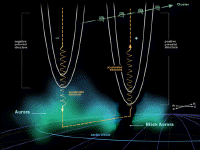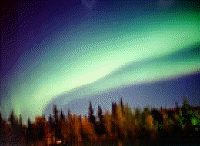Electrifying aurorae
People living at high latitudes may have to endure long, icy winters, but Nature has stepped in to offer some compensation in the form of the aurorae - the beautiful, shimmering curtains of red and green that illuminate the polar skies.
Shimmering curtains of red and green illuminate the polar skies. (Copyright Till Credner, AlltheSky.com | |
|
|
This dazzling display is made possible by Nature's own electron gun. Just as pictures on our TV sets are generated by electron beams hitting a screen, so negatively charged particles from space shoot down the Earth's magnetic field lines. When they strike the upper atmosphere above the polar regions, they cause the atoms and molecules to glow.
 Electrons and aurorae
Electrons and aurorae
Every day we use a variety of electrical appliances - TV, CD player, washing machine .... the list is endless. What makes these modern marvels work is a vast migration of electrons (negatively charged particles), flowing through wires and cables.
Planet Earth is also associated with various natural electrical systems. The best known example of atmospheric electricity is the lightning flash, a sudden flow of electrons between a cloud and the ground.
At higher altitudes, between 60 km and 600 km above the Earth, is the ionosphere, a sparse layer of atmosphere filled with billions of negatively charged electrons and positively charged atomic particles called ions. This is the home of the aurorae - the Northern and Southern Lights.
Higher still is the magnetosphere, a huge invisible bubble populated by free electrons and ions that sweep around the planet, guided by its magnetic field. Some of the particles inside this magnetic bubble originated in the Sun and sneaked in through the Earth's outer defences. Others began life in the ionosphere and rose to a higher existence.
It is these electrons and their effects on their surroundings which are detected by identical instruments on each member of the Cluster quartet as the particles soar up and down the magnetic field lines between the ionosphere and the magnetosphere.
By analysing the data from instruments on Cluster and other spacecraft, scientists are now able to study in detail what happens during a typical aurora.
 Creating the aurora
Creating the aurora
"We have known for a long time that auroras are caused by fast-moving electrons that collide with atoms in the upper atmosphere," said Professor Göran Marklund of the Alfvén Laboratory in Sweden, a co-investigator with the EFW (electric field and wave) experiment on ESA's Cluster mission.
The aurorae are caused by fast-moving electrons that are accelerated to high energies as they follow the magnetic field lines in narrow, U-shaped vertical structures | |
|
|
"These electrons are accelerated to high energies - several keV (thousand electronvolts) - as they follow the magnetic field lines," he said.
"We see this happening in narrow, U-shaped vertical structures above the aurora," he explained. "These features start at a height of several thousand kilometres and reach far into space. We call them 'electric potential structures' and they can be negatively or positively charged."
The particles in the structures are accelerated upward or downward, depending on the direction of the electric field.
A negatively charged structure, which has an upward electric field component, accelerates the incoming electrons downward to produce aurorae.
A positively charged structure has a downward electric field component that accelerates electrons upward away from the ionosphere towards the magnetosphere. The ionospheric signature of such a structure is a growing hole in the electron density and 'black aurora', visible to the eye if embedded in an area of diffuse (faint) aurora.
Black aurorae, such as the dark band running through the green-coloured aurora in this photograph, can only be seen with the naked eye if embedded in a diffuse (faint) aurora. (Copyright Jan Curtis, Fairbanks, Alaska) | |
|
|
Like some giant cosmic battery, these negatively and positively charged structures are often found together. They are linked by an electrical circuit that includes the aurora, the upward auroral current and the downward return current.
The existence of positive potential structures in the downward current region was first reported in 1994 by Professor Marklund and his colleagues, based on observations made at low altitude (1700 km) by the Swedish Freja satellite.
However, until now, no one has been able to find out how the huge vertical structures form, how long they last or how they vary with altitude. Only since the arrival of Cluster have scientists been able to carry out a detailed investigation of what goes on inside these mysterious particle accelerators.



